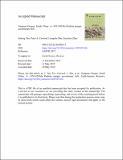Jiangnan Orogen, South China : a ~970–820 Ma Rodinia margin accretionary belt
Abstract
The Neoproterozoic Jiangnan Orogen in South China records a succession of arc-trench-basin assemblages culminating in accretion of the bounding Yangtze and Cathaysia blocks to form the stabilized South China Craton. The orogen can be traced over some 1500 km and extends up to 100 km across strike. It is divisible into three domains: the northeast domain (also referred to as the Huaiyu or Shuangxiwu Terrane), the central domain (Jiuling Terrane), and an undifferentiated southwest domain. The northeast domain contains arc type volcanic suites and I-type granitoids dated at ca. 970–850 Ma. It is interpreted as an intra–oceanic terrane based on the juvenile radiogenic isotopic signature of the igneous rocks, the absence of older detritus and inherited xenocrysts, and the presence of ophiolites along its southwestern and western margins. The central and southwest domains contain trench-arc-basin assemblages of clastic sedimentary units, mappable magmatic arc suites and ophiolitic mélanges (Sibao and equivalent groups) that range in age from ca. 880 to 820–815 Ma. The presence of old zircon grains within these two domains, both as detritus within sedimentary units and as inherited zircon in arc basalt, suggest they formed at convergent continental margins. S-type granites dated at 845–815 Ma are a distinctive element of the central and southwest domains. The ages of these granites overlap with convergent plate magmatism in the two domains, arguing against previous models for plume-rift and post-collisional geodynamic settings. Instead, these bodies likely formed in an accretionary orogenic margin setting in which granitic magmatism occurred in an extensional regime triggered by slab rollback. The slab-rollback process triggered mantle-sourced thermal input and partial melting of the older and buried arc-bounding basin sediments. Early Paleozoic S-type granites in the Lachlan and New England belts in eastern Australia and Jurassic ones in the Cordillera belt of the western US provide analogous geodynamic environments. Isotopic data indicate that the central Jiangnan domain experienced significant crustal growth, whereas in the southwest domain there was a greater degree of crustal reworking. The character and distribution of the early Neoproterozoic sedimentary and igneous succession in the orogen suggests it represents a ca. 970–820 Ma accretionary orogen. Upper age limits on the Jiangnan Orogen are provided by a regional angular unconformity in the central and southwest domains at ca. 810–805 Ma, and in the northeast domain at ca. 825 Ma, along with the overlying bimodal volcanic and clastic sedimentary successions mostly dated at ca. 810–730 Ma. Thus, timing of final assembly of South China displays variations across the Jiangnan Orogen, from ca. 825 Ma in the northeast to ca. 820–805 Ma in the central and southwest of the orogen. Post-assembly successions are parts of the Nanhua Basin and are interpreted to have formed during regional lithospheric extension across the eastern and central South China Craton. The age patterns across the South China Craton are indicative of northwest directed accretion of fragments and suggest an external rather than an internal position of the craton within the assembled Rodinia supercontinent. Paleomagnetic data, regional correlations and sedimentary records are consistent with a position along the northern margin of Rodinia, adjacent to India and Australia. The Jiangnan Orogen recorded the accretion of trench-arc assemblages and ultimately the Yangtze Block to the Cathaysia Block that was already located on the margin of Rodinia. The Panxi-Hanan belt, which lies along the western and northwestern margin of the Yangtze Block, formed on the upper plate to a subduction system that both overlaps with, and is younger than, the Jiangnan Orogen. The belt provides a record of ongoing accretion on the Rodinia margin until the mid-Neoproterozoic.
Citation
Yao , J , Cawood , P A , Shu , L & Zhao , G 2019 , ' Jiangnan Orogen, South China : a ~970–820 Ma Rodinia margin accretionary belt ' , Earth Science Reviews , vol. 196 . https://doi.org/10.1016/j.earscirev.2019.05.016
Publication
Earth Science Reviews
Status
Peer reviewed
ISSN
0012-8252Type
Journal article
Description
Authors thank the Major State Research Development Program of China (Grant No. 2016YFC0600202) for financial support, as well as financial support from National Natural Science Foundation of China (Nos. 41330208, 41572200 and 41190070) and State Key Laboratory for Mineral Deposits Research (Nanjing University) (ZZKT–201603). Peter A. Cawood acknowledges support from Australian Research Council grant FL160100168.Collections
Items in the St Andrews Research Repository are protected by copyright, with all rights reserved, unless otherwise indicated.

